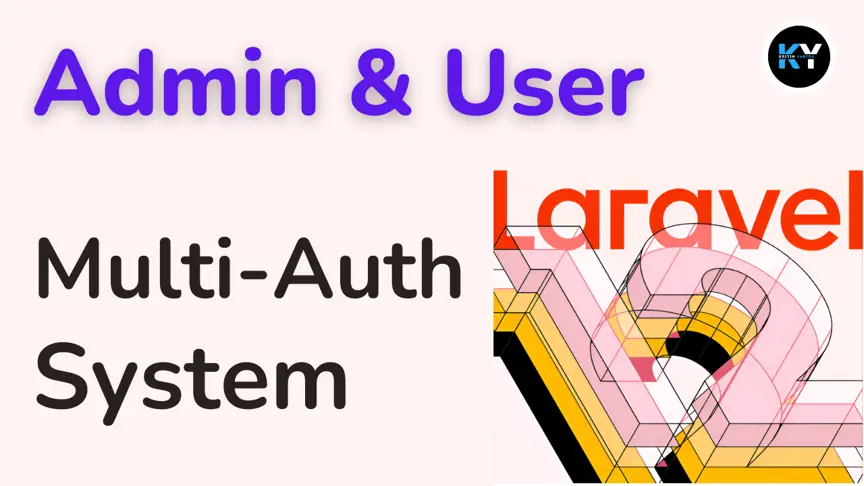Laravel 12 with JWT Authentication: A Beginner-Friendly Guide

Kritim Yantra
Mar 28, 2025
If you're building a web or mobile app, you’ll need a secure way to authenticate users. JSON Web Tokens (JWT) are a popular solution because they allow stateless, token-based authentication.
In this guide, we’ll learn how to:
✔ Set up JWT in Laravel 12
✔ Create login & registration APIs
✔ Protect routes with JWT
✔ Test the API using Postman
By the end, you'll have a fully working JWT authentication system in Laravel!
🔹 What is JWT?
JWT (JSON Web Token) is a secure way to transmit data between a client (like a React app) and a server (Laravel).
How JWT Works
- User logs in → Server generates a token.
- Token is stored (e.g., in browser
localStorage). - Every API request includes this token for authentication.
- Server verifies the token before allowing access.
🔐 Why use JWT?
✅ No need for sessions (stateless)
✅ Works well with mobile apps & SPAs
✅ Secure (signed with a secret key)
🔹 Step 1: Setting Up Laravel 12
1. Install Laravel
composer create-project laravel/laravel laravel-jwt
cd laravel-jwt
2. Install API
php artisan install:api
3. Install JWT Package
We’ll use tymon/jwt-auth, a popular Laravel JWT package.
composer require tymon/jwt-auth
4. Publish JWT Config
php artisan vendor:publish --provider="Tymon\JWTAuth\Providers\LaravelServiceProvider"
5. Generate JWT Secret Key
php artisan jwt:secret
This adds a JWT_SECRET key in .env.
🔹 Step 2: Configure Laravel for JWT
1. Update config/auth.php
Change the default guard to api with JWT driver:
'defaults' => [
'guard' => 'api',
'passwords' => 'users',
],
'guards' => [
'api' => [
'driver' => 'jwt',
'provider' => 'users',
],
],
2. Modify the User Model
Update app/Models/User.php to implement JWTSubject:
use Tymon\JWTAuth\Contracts\JWTSubject;
class User extends Authenticatable implements JWTSubject
{
// ...
public function getJWTIdentifier()
{
return $this->getKey(); // Returns user ID
}
public function getJWTCustomClaims()
{
return []; // Extra data in token (optional)
}
}
🔹 Step 3: Create Auth APIs
1. Make Auth Controller
php artisan make:controller AuthController
2. Add Login & Register Logic
Update app/Http/Controllers/AuthController.php:
use Illuminate\Http\Request;
use App\Models\User;
use Illuminate\Support\Facades\Auth;
class AuthController extends Controller
{
public function register(Request $request)
{
$request->validate([
'name' => 'required|string',
'email' => 'required|email|unique:users',
'password' => 'required|min:6',
]);
$user = User::create([
'name' => $request->name,
'email' => $request->email,
'password' => bcrypt($request->password),
]);
$token = Auth::login($user);
return response()->json([
'status' => 'success',
'token' => $token,
'user' => $user,
]);
}
public function login(Request $request)
{
$request->validate([
'email' => 'required|email',
'password' => 'required',
]);
$credentials = $request->only('email', 'password');
if (!$token = Auth::attempt($credentials)) {
return response()->json(['error' => 'Unauthorized'], 401);
}
return response()->json([
'status' => 'success',
'token' => $token,
'user' => Auth::user(),
]);
}
public function user()
{
return response()->json(Auth::user());
}
}
3. Define API Routes
In routes/api.php:
use App\Http\Controllers\AuthController;
Route::post('register', [AuthController::class, 'register']);
Route::post('login', [AuthController::class, 'login']);
Route::middleware('auth:api')->get('user', [AuthController::class, 'user']);
🔹 Step 4: Testing with Postman
1. Register a User
- Method:
POST - URL:
http://localhost:8000/api/register - Body (JSON):
{
"name": "John Doe",
"email": "john@example.com",
"password": "password123"
}
✅ Response:
{
"status": "success",
"token": "eyJhbGciOiJIUzI1NiIs...",
"user": { "id": 1, "name": "John Doe", "email": "john@example.com" }
}
2. Login
- Method:
POST - URL:
http://localhost:8000/api/login - Body (JSON):
{
"email": "john@example.com",
"password": "password123"
}
✅ Response: Same as register (with a new token).
3. Get User Data (Protected Route)
- Method:
GET - URL:
http://localhost:8000/api/user - Headers:
Authorization: Bearer eyJhbGciOiJIUzI1NiIs...
✅ Response:
{ "id": 1, "name": "John Doe", "email": "john@example.com" }
🔹 Common Issues & Fixes
1. "Token not provided" error
✅ Solution: Ensure the Authorization header is correctly formatted:
Authorization: Bearer your_token_here
2. "Token expired" error
✅ Solution:
- Increase token lifetime in
.env:JWT_TTL=1440 # (in minutes) - Or implement token refreshing (advanced).
3. CORS Errors
✅ Solution: Install fruitcake/laravel-cors:
composer require fruitcake/laravel-cors
Then enable it in config/cors.php.
🔹 Conclusion
🎉 You’ve successfully set up JWT in Laravel 12!
What We Covered:
✔ Installed & configured JWT
✔ Created register/login APIs
✔ Protected routes with JWT middleware
✔ Tested with Postman
Happy coding! 😊🚀
Comments
No comments yet. Be the first to comment!
Please log in to post a comment:
Sign in with GoogleRelated Posts

 Kritim Yantra
Kritim Yantra
 Kritim Yantra
Kritim Yantra
